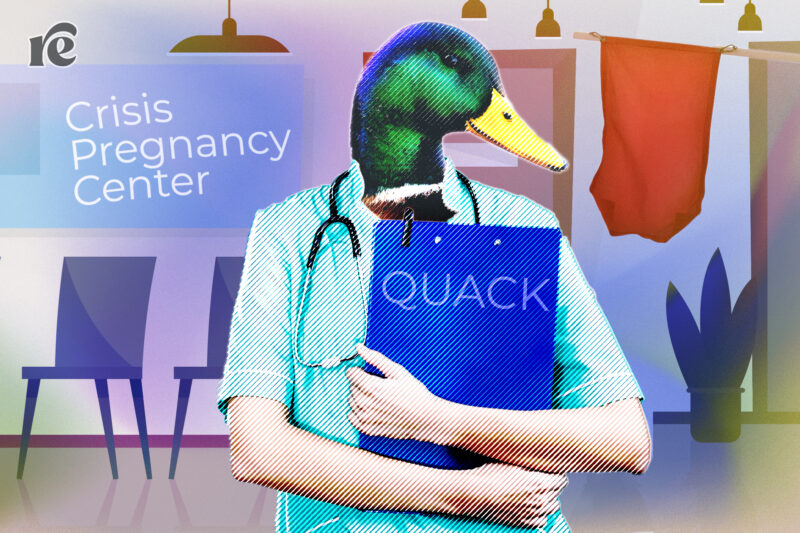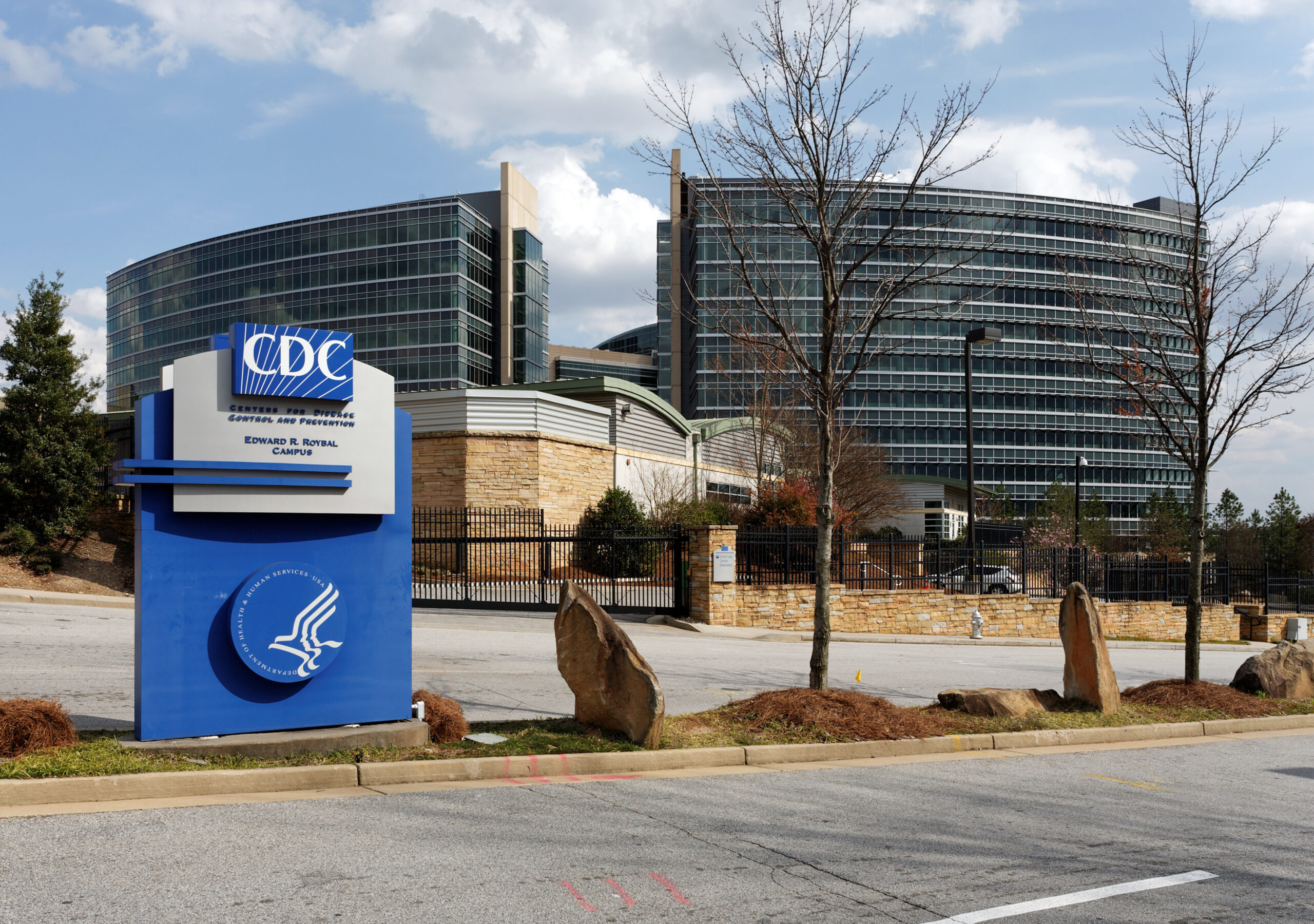Why Won’t the CDC Kick “Crisis Pregnancy Centers” Out of Its Directories?
If you're looking for an STI test and visit gettested.cdc.gov, you might accidentally end up at a CPC.

Danielle Lambert is a researcher focused on “crisis pregnancy centers,” or anti-abortion centers. Imagine her frustration when she searches a federal government directory of sexual health services and the top hit is… a crisis pregnancy center (CPC).
“I live within minutes of the Department of Public Health and within minutes of several comprehensive family planning clinics,” said Lambert. But when she searches in the National Prevention Information Network (NPIN) database, a nearby CPC tops the list.
CPCs are primarily known for their main purpose, which is to convince people not to have abortions, often using deceptive tactics. However, over the last decade or so, some of them have begun to offer limited medical services, perhaps in an attempt to counter the “fake clinic” moniker that many advocates have applied to them. It’s also a ploy to gobble up more government funding.
Increasingly, these medical services include STI testing, and that’s why many CPCs are appearing in directories maintained by divisions of the Centers for Disease Control and Prevention (CDC). These include the main NPIN database, which is aimed toward public health professionals, and the public-facing Get Tested directory, which is populated by the same data set. Advocates and researchers like Lambert tell Rewire News Group that they’ve been raising concerns about this to the CDC for years, to no avail.
Lambert is an assistant professor in the epidemiology and biostatistics department at the University of Georgia College of Public Health. She co-developed the Crisis Pregnancy Center Map, an interactive directory intended to increase public awareness of CPCs and facilitate academic research related to them.
Prior to that, Lambert’s work dealt primarily with HIV prevention, and NPIN provided data for some of her research regarding accessibility of HIV services in the Deep South. It was then, around 2016 or 2017, that she first noticed CPCs popping up in the database and initiated a conversation with NPIN staff about it. They told her that the information in the database is self-reported, she said. Since then, Lambert added, she and her fellow CPC Map researchers have had several follow-up conversations with the CDC. No apparent changes have been made.

The CPC Map team aren’t the only ones to have noticed: Lidia Carlton, a sexual health educator who previously worked for the California Department of Public Health in its STD control branch, said she and her supervisor raised the same issue to the CDC in 2016 or earlier.
Cross-referencing results between the CPC Map and NPIN, you can see just how easy it would be to unknowingly select a CPC if you were looking for a place to get tested. Many of them have nondescript names that sound like any other sexual or reproductive health clinic, and they often obscure their religious affiliations. They’re largely indistinguishable from other results in the NPIN database unless you know what you’re looking for.
Lending CPCs legitimacy
How many CPCs are offering STI testing and treatment services, exactly? In 2018 and 2019, Lambert and some colleagues set out to determine just that, conducting the first national analysis on the subject. First, they identified 2,524 CPCs operating in the United States. Then, they combed through the centers’ websites and attempted to contact them directly, reaching almost all of them on the phone. Their findings were published in the journal Sexually Transmitted Diseases in 2021.
Their study found that just over 21 percent of CPCs advertised STI testing on their websites. However, fewer than 5 percent advertised HIV testing specifically, and only about 12 percent advertised any kind of STI treatment. Of the centers contacted by phone, most offered testing for only two STIs. Only about 15 percent offered any STI treatment. More than one-fifth of the CPCs that offered testing didn’t even offer treatment referrals.
In other words, the number of CPCs advertising STI-related services isn’t particularly large. But the fact that so many of those that do appear in federal government directories—maintained by the agency meant to control and prevent diseases, no less—lends them legitimacy. And given what researchers, advocates, and patients know about how CPCs operate, there are a lot of reasons to be concerned about people being directed there for sexual health services.
Red flags
First, Lambert points to the fact that most CPCs tested for only one or two STIs. The CDC’s own guidelines encourage more comprehensive testing than that for most people. In particular, they recommend that anyone who presents for “evaluation and treatment of STIs” be tested for HIV, even when other risk factors aren’t present.
The fact that so few CPCs offer STI treatment onsite, or even referrals, also runs afoul of best practices for treatment and prevention, Lambert said.
“If people are coming to a CPC to access testing services, but then they have to go somewhere else for treatment, especially if they have to find that place on their own, that could be a drop-off point for some people, or just delay them in getting treatment,” she said.
Many states have made it possible for providers to offer a CDC-backed approach called expedited partner therapy, Lambert added. This means that when a person is diagnosed with certain STIs, a health-care provider can give them prescriptions or medications to give to their partner directly, without that partner having to come into a clinic themselves. This saves time, helps prevent further spread of the STI, and prevents partners from reinfecting each other. In Lambert’s study, however, very few CPCs—under 6 percent of those that offered STI services—said they offered expedited partner therapy.
“Even above and beyond that, in terms of the quality of services that are likely to be offered by CPCs, many of them are run by lay volunteers,” Lambert said. “So there aren’t licensed health practitioners on site. And they are anti-contraception, including condoms. So if you think about what kind of information someone’s getting if they come in for HIV or STI testing, there are a lot of public health concerns.”
All of this is happening as the United States fails to turn around or even stem the tide of rapidly rising STI rates. This trend began before, but was accelerated by, the pandemic: Since 2017, syphilis cases have increased by 74 percent, and cases of gonorrhea—which is rapidly becoming more and more resistant to antibiotics—have risen by 28 percent. After several years of declining HIV rates, the United States saw a 16 percent increase in new cases in 2021. That’s despite a dramatic decrease in testing rates during the pandemic, suggesting that more new infections could have gone undetected.
Tempting as it might be to think that CPCs are responding to community needs by providing testing services, that doesn’t seem to be the case—Lambert’s study found no correlation between STI rates in a given community and the likelihood that CPCs there offered testing.
How CPCs cause harm
Some experts doubt that CPCs are even offering the testing and treatment services they advertise.
“If you were actually to show up to one of these CPCs, I’m skeptical that they would even be ready to test you, because the tests are kind of expensive,” said Maria Gallo, associate dean of research and professor of epidemiology at the Ohio State University College of Public Health.

Services at CPCs are generally offered free of charge (though “free” isn’t always free—clients are often required to watch videos, attend classes, or participate in church activities to get what they came for). Still, advertising free services is a tactic that helps CPCs attract patients who might otherwise choose a legitimate medical facility, particularly in low-income areas. However, STI tests are more expensive than, for example, urine pregnancy tests, meaning they’re not a particularly cost-effective way of drawing clients.
“It’s also not something that’s aligned with their mission. So you might go to all the trouble of going there instead of, say, going to your health department to be tested, and you could arrive and discover you can’t actually get tested for STIs there,” said Gallo, echoing Lambert’s concern about potential delays in care.
Another concern, she said, is that CPCs are known to propagate misinformation and lean heavily into stigma. This isn’t necessarily because CPC volunteers intend to mislead people; in fact, many of them may believe that the information they’re sharing is accurate. However, while they appear to be community-based organizations, most CPCs are either run by or affiliated with a handful of large, national networks. It’s these organizations that provide volunteer training materials rife with disinformation.
For a forthcoming study, Gallo and her colleagues conducted in-depth interviews with CPC volunteers. They also reviewed the training materials the CPCs in question were using, and found that volunteers were repeating inaccurate health statements found in the materials. Examples include the medically invalid and potentially dangerous idea that medication abortion can be “reversed,” claims that contraception is unsafe, and even the false statement that using contraception can cause you to get an STI.
“So I would be concerned about someone going to a CPC for testing because they’re not going to receive accurate information, and … the CPC will use stigma to try to influence how that person behaves,” Gallo said.
Lambert pointed to another example from a study in which she and her colleagues interviewed people who went to CPCs.
“One of the interviews that we did was with a young person who went to a CPC thinking that she could get birth control there. And after one appointment, she had changed her mind and felt that birth control was no longer a good option for her, not realizing that they actually didn’t even provide any type of contraception there,” Lambert said.
“There’s a real lack of trauma-informed and patient-centered care,” she added. “For example, volunteers and staff members telling victims of sexual violence that it was a blessing that this happened to them or to see the ‘silver lining.’”
Given that most of them have conservative Christian affiliations, CPCs also tend to espouse anti-LGBTQ rhetoric. Exposure to these intersecting forms of stigma and misinformation could affect people’s health and lives for years to come. And because most CPCs aren’t real medical facilities, they’re also not subject to the Health Insurance Portability and Accountability Act (HIPAA), and have been known to surveil patients and misuse the information they collect about them.
It’s also not just the CDC pointing people toward CPCs: Gallo notes that many states, including Ohio, require abortion providers to distribute state-provided resource booklets to patients, which often include CPC websites and phone numbers. More than that, numerous states directly fund “crisis pregnancy centers” through a combination of state tax dollars and even by diverting money from federal programs such as Temporary Assistance for Needy Families (TANF).
Can CPCs be regulated?
Experts agree: There’s no reason for CPCs to appear in CDC resources.
“The CDC is the United States’ public health protection agency. Its National Center for HIV, Viral Hepatitis, STD, and TB Prevention is supposed to work to confront the root causes of the country’s STI epidemics and crises, and improve access to care and treatment for our most underserved populations,” said Madeline Morcelle, a senior attorney with the National Health Law Program. “And just one of the ways it does that is through its Get Tested program. But including CPCs there really runs counter to that mission.”
Lambert said that, at a minimum, she’d like to see a process in place for vetting the facilities listed in NPIN. Morcelle thinks the CDC needs to go further.
“In addition to removing CPCs entirely, the CDC should make clear that they will not include clinics that provide medically inaccurate and misleading information in any service context,” Morcelle said. “I think they should make a public statement about the removal of CPCs and the fact that they do not provide medically accurate information and are not actually real health centers.”
“I think in determining standards going forward for what kinds of health-care organizations should be included, the CDC should consult and work closely with reproductive justice and LGBTQI+ rights organizations that best understand what’s at stake for, and the kinds of issues encountered by Black women, LGBTQI+ people, and other underserved populations that are most harmed by CPCs,” Morcelle added.
It would certainly be a powerful statement for the federal government to take such a stance, especially given that efforts to regulate CPCs were hamstrung by the 2018 Supreme Court ruling in NIFLA v. Becerra. In that case, which largely flew under the radar in terms of public discussion, the National Institute of Family and Life Advocates—one of the major CPC umbrella organizations—sued the state of California over a law that required CPCs to disclose that they weren’t real medical facilities and give clients information about the state’s free and low-cost family planning resources. NIFLA won. The law was struck down.
However, some advocates and lawmakers are beginning to try new regulatory approaches. Last summer, Massachusetts Sen. Elizabeth Warren introduced a bill that would direct the Federal Trade Commission to create new rules requiring CPCs to be truthful in their advertising. Shortly thereafter, Los Angeles adopted an ordinance with a similar “truth in advertising” angle, and late last year, New Jersey Attorney General Matt Platkin issued a consumer alert about CPCs.
The HIV/AIDS-focused reproductive justice organization SisterLove, which provides direct services in addition to its advocacy and education programs, is working with legislators in its home state of Georgia to introduce a similar bill in the next legislative session, according to the organization’s policy and advocacy program manager Christopher Reed.
“If we can’t eradicate CPCs altogether, we can at least find a way to eradicate some of their practices,” he said.
According to the Guttmacher Institute, a total of 21 bills to regulate CPCs have been introduced on the state level so far in 2023. However, even when signed into law, these policies face an uphill battle given the willingness of large and well-funded anti-abortion organizations to litigate them. Take, for example, Colorado, which recently enacted a law banning CPCs from engaging in false advertising and from offering medication abortion “reversal.” The law has already been challenged in court and is temporarily blocked.
It seems that the very least the federal government could do in this area—after President Joe Biden promised a “whole-of-government effort” to protect abortion access—is to stop legitimizing CPCs by listing them in federal databases.
In response to a request for comment, however, a CDC representative did not acknowledge the presence of CPCs in the NPIN database. He shared a link to the criteria for inclusion, but the linked document does not include information about how or whether the CDC vets self-reported information from listed facilities.

